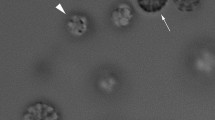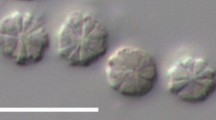Abstract
Magnetotactic microorganisms are characterized by swimming in the direction of an applied magnetic field. In nature, two types of swimming polarity have been observed: north-seeking microorganisms that swim in the same direction as the magnetic field, and south-seeking microorganisms that swim in the opposite direction. The present work studies the reversal in the swimming polarity of the multicellular magnetotactic prokaryote Candidatus Magnetoglobus multicellularis following an isolation process using high magnetic fields from magnets. The proportion of north- and south-seeking organisms was counted as a function of the magnetic field intensity used during the isolation of the organisms from sediment. It was observed that the proportion of north-seeking organisms increased when the magnetic field was increased. The magnetic moment for north- and south-seeking populations was estimated using the U-turn method. The average magnetic moment was higher for north- than south-seeking organisms. The results suggest that the reversal of swimming polarity must occur during the isolation process in the presence of high magnetic fields and magnetic field gradients. It is shown for the first time that the swimming polarity reversal depends on the magnetic moment intensity of multicellular magnetotactic prokaryotes, and new studies must be undertaken to understand the role of magnetic moment polarity and oxygen gradients in determination of swimming polarity.






Similar content being viewed by others
References
Abreu F, Martins JL, Silveira TS, Keim CN, Lins de Barros HGP, Gueiros Filho FJ, Lins U (2007) ‘Candidatus Magnetoglobus multicellularis’, a multicelular, magnetotactic prokaryote from a hypersaline environment. IJSEM 57:1318–1322
Acosta-Avalos D, Azevedo LMS, Andrade TS, Lins de Barros H (2012) Magnetic configuration model for the multicelular magnetotactic prokaryote Candidatus Magnetoglobus multicellularis. Eur Biophys J 41:405–413
Bazylinski DA, Frankel RB (2004) Magnetosome formation in prokaryotes. Nat Rev Microbiol 2:217–230
Blakemore RP, Frankel RB, Kalmijn AJ (1980) South-seeking magnetotactic bacteria in the Southern hemisphere. Nature 286:384–385
Cai J, Wang L, Wu P, Li Z, Tong L, Sun S (2008) Study on oxygen enrichment from air by application of the gradient magnetic field. J Magn Magn Mater 320:171–181
Esquivel DMS, Lins de Barros HGP (1986) Motion of magnetotactic microorganisms. J Exp Biol 121:153–163
Frankel RB, Blakemore RP, Torres de Araujo FF, Esquivel DMS, Danon J (1981) Magnetotactic bacteria at the geomagnetic equator. Science 212:1269–1270
Keim CN, Martins JL, Lins de Barros H, Lins U, Farina M (2006) Structure, behavior, ecology and diversity of multicelular magnetotactic prokaryotes. In: Schuler D (ed) Magnetoreception and magnetosomes in bacteria. Springer-Verlag, Berlin, pp 103–132
Lins U, Freitas F, Keim CN, Lins de Barros H, Esquivel DMS, Farina M (2003) Simple homemade apparatus for harvesting uncultured magnetotactic microorganisms. Braz J Microbiol 34:111–116
Penninga I, de Waard H, Moskowitz BM, Bazylinski DA, Frankel RB (1995) Remanence measurements on individual magnetotactic bacteria using a pulsed magnetic field. J Magn Magn Mater 149:279–286
Perantoni M, Esquivel DMS, Wajnberg E, Acosta-Avalos D, Cernicchiaro G, Lins de Barros H (2009) Magnetic properties of the microorganism Candidatus Magnetoglobus multicellularis. Naturwissenschaften 96:685–690
Pop F, Armitage JP, Schuler D (2014) Polarity of bacterial magnetotaxis is controlled by aerotaxis through a common sensory pathway. Nat Commun 5:5398
Rodgers FG, Blakemore RP, Blakemore NA, Frankel RB, Bazylinski DA, Maratea D, Rodgers C (1990) Intercellular structure in a many-celled magnetotactic prokaryote. Arch Microbiol 154:18–22
Simmons SL, Bazylinski DA, Edwards KJ (2006) South-seeking magnetotactic bacteria in the Northern hemisphere. Science 311:371–374
Torres de Araujo FF, Germano FA, Gonçalves LL, Pires MA, Frankel RB (1990) Magnetic polarity fractions in magnetotactic bacterial populations near to geomagnetic equator. Biophys J 58:549–555
Winklhofer M, Abraçado LG, Davila AF, Keim CN, Lins de Barros HGP (2007) Magnetic optimization in a multicellular magnetotactic organism. Biophys J 92:661–670
Zhang WJ, Chen C, Li Y, Song T, Wu LF (2010) Configuration of redox gradient determines magnetotactic polarity of the marine bacteria MO-1. Environ Microbiol Rep 2:646–650
Acknowledgements
The authors thank Dr. Henrique Lins de Barros for fruitful discussion and suggestions, Dr. Steven Frederick Durrant from UNESP, Sorocaba, SP, Brazil for correcting the English of the manuscript, and the Conselho Nacional de Desenvolvimento Cientifico e Tecnologico—CNPq, Brazil and Fundação Carlos Chagas Filho de Amparo à Pesquisa do Estado do Rio de Janeiro—FAPERJ, Rio de Janeiro, Brazil for financial support.
Author information
Authors and Affiliations
Corresponding author
Electronic supplementary material
Below is the link to the electronic supplementary material.
249_2017_1199_MOESM1_ESM.pdf
Table II: Values for the radius R, U-turn time t u, ratio t u/R 3, and corresponding values for the magnetic moment m, calculated using Eq. (1), ordered according to the magnetic field used in the isolation process and the type of swimming polarity. The corresponding statistics are summarized in Table I (PDF 130 kb)
Video 1: Isolation of MMPs with the magnetic south pole facing the capillary end. The magnetic field measured at the capillary end was 460 Oe. The video starts at the drop border where SS MMPs should accumulate (3gp 3330 kb)
Video 2: Isolation of MMPs with the magnetic north pole facing the capillary end. The magnetic field measured at the capillary end was 460 Oe. The video starts at the drop border where SS MMPs should accumulate (3gp 4650 kb)
Video 3: Isolation of MMPs with the magnetic north pole facing the capillary end. The magnetic field measured at the capillary end was 15 Oe. The video starts at the drop border where SS MMPs should accumulate (3gp 3789 kb)
Rights and permissions
About this article
Cite this article
de Melo, R.D., Acosta-Avalos, D. The swimming polarity of multicellular magnetotactic prokaryotes can change during an isolation process employing magnets: evidence of a relation between swimming polarity and magnetic moment intensity. Eur Biophys J 46, 533–539 (2017). https://doi.org/10.1007/s00249-017-1199-5
Received:
Revised:
Accepted:
Published:
Issue Date:
DOI: https://doi.org/10.1007/s00249-017-1199-5




